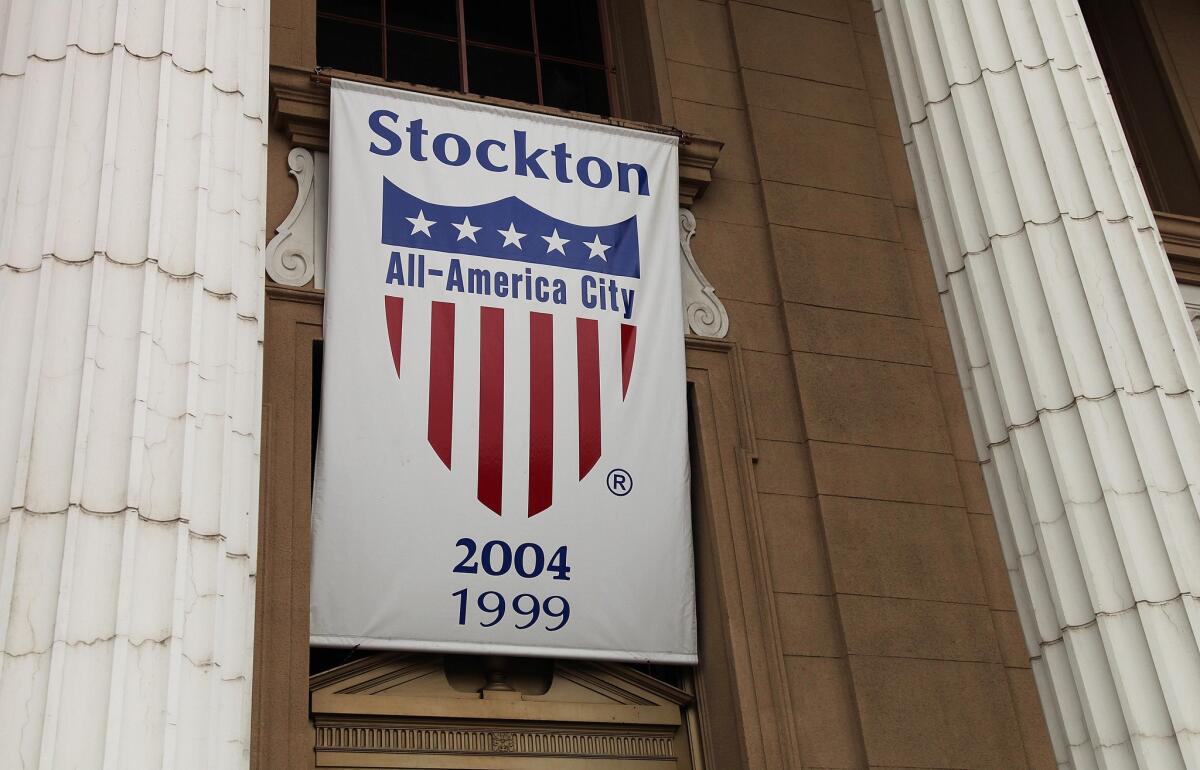In Stockton bankruptcy case, the target is the working class

- Share via
The investment house Franklin Templeton’s effort to knock down the city of Stockton’s proposal to emerge from bankruptcy portrays the case as one in which Franklin is defending itself against three big, faceless adversaries.
These are CalPERS, California’s enormous public pension agency, and “the City and its organized labor allies.” Franklin objects that they’re angling to preserve their preferential position in the bankruptcy reorganization, while cramming down big losses on Franklin, which holds more than $36 million in city debt, of which some $32 million is unsecured. The city proposes to pay Franklin about 1 cent on the dollar for that unsecured portion.
But of course this is not a battle of big institutions. You have to read fairly carefully in Franklin’s brief to recognize who would be the real victims of its position: 2,400 retirees whose retirement benefits already have been cut, and whose income would be eviscerated if Franklin gets its way.
CalPERS wouldn’t be hurt; it would just pass on its losses to the retirees by cutting their pensions, as Franklin states explicitly. “Organized labor”? That’s Wall Street’s contemptuous way of referring to workers who’ve had the temerity of banding together to protect their own rights.
On Wednesday, Bankruptcy Judge Christopher Klein rattled pension advocates across the country by concluding that Stockton’s contract with CalPERS to manage its pension fund was conditional, like any other contract in bankruptcy: “I’ve concluded that pensions could be adjusted,” he declared.
This was a cavalier way of agreeing that no one important would be injured if, as Franklin asserts, Stockton stiffed CalPERS on the $1.6-billion termination fee it would normally have to pay for ending the pension contract. That fee would cover the city’s unfunded liability for its workers’ benefits. CalPERS would simply cover the shortfall by taking it out of the retirees’ checks.
Franklin sugarcoats the implications of its demand by painting Stockton’s retirees as grasping crooks. The city’s pension liability, it asserts, was “brought about by years of ‘pension spiking’ and unfunded promises of lavish benefits.”
These certainly are familiar terms bandied about whenever public employee pensions are discussed. As for evidence that they’re applicable here, as the bankruptcy case’s retirees committee pointed out, no evidence of spiking was presented in court, much less that it had anything to do with Stockton’s bankruptcy.
“Lavish” pensions? The average pension benefit for retired Stockton workers is $24,000 a year. Were Stockton to be forced out of CalPERS, the city’s pension expert testified, those pensions would have to be cut by 60%, leaving the average retiree with $9,600 a year.
Franklin scoffs at the city’s assertion that eviscerating employees’ pensions would trigger a wholesale flight of municipal workers. The investment firm’s argument boils down to: They’re already screwed, so why would they bother?
“Given that there is nothing that can be done about benefits earned through the date of impairment”--that is, the benefits are lost, no use crying over them--”economically-rational employees...would do what all other economically-rational actors would do: they would consider what future job opportunity offers the best compensation package going forward.” (Emphasis in the original.)
Anyway, Franklin adds, they’re likely to stay put because moving is a pain in the neck, what with “the need to uproot home and leave family and friends.” Bizarrely, the investment firm suggests that decimating benefits now will give the city “enormous flexibility to develop at- or above-market compensation packages” in the future.
Right, and we can assume that were the city to do so and get into trouble again, Franklin Templeton would be at the front of the line blaming Stockton for its “lavish” compensation of employees.
Franklin’s complaint that it’s being uniquely disadvantaged in the bankruptcy reorganization falls apart when one examines what Stockton’s employees and retirees already have sacrificed. Among other cuts, city employees were hit with involuntary furloughs in 2008 through 2012, gave up cost of living increases for several years, and began paying a retirement contribution of up to 9% in 2011. New employees already receive sharply reduced benefits. (A full list is here.)
The biggest hit involved retiree health benefits, which were negotiated in past years as an alternative to wage increases. Eventually, the city’s actuarial exposure to health claims by 1,100 retirees reached $545 million. As part of a bankruptcy settlement with retirees, that was reduced to $5.1 million--the same 1% payoff Franklin is grousing about--and lifetime health benefits were eliminated.
The $5.1 million is to be paid out in lump sums ranging from $460 to $14,000; as the retirees committee observed, the one-time payments are “not enough to cover even one year of premiums for replacement health insurance and for many...without providing any coverage for dependents that were covered by the city’s plan.”
The argument that employees and retirees are just like any unsecured creditors, and should simply stand in line for a payout like Franklin’s clients, is pure Wall Street sophistry. Bondholders know when they make their investments that any return is contingent; that’s why bond interest rates vary according to the security and creditworthiness of the borrower.
Employees make a different deal. Unlike an investment fund, which can diversity its portfolio to hedge against the risk that some bond issuers will fail, employees can’t diversify their employment portfolio by taking several jobs at once to guard against the chance that one employer might default on its obligations. In return for committing years to an employer, they receive some pay now, and some pay deferred via a pension.
Federal law recognizes that a private pension is sacrosanct, prohibiting employers from reducing pensions after they’ve been earned and establishing a government-guaranteed backup. The California legislature took similar pains to give public pension obligations a special status, even in municipal bankruptcies. Judge Klein’s position is that state law has no weight in federal bankruptcy court, and that Stockton’s pension promises are conditional and unprotected. Given that federal preemption of state law is an established principle, he may be right.
But bankruptcy court is also expected to leave the emerging bankrupt in decent shape to move forward, and it’s hard to see how injecting a new uncertainty into any worker’s expectation of promised pay and benefits makes the residents of Stockton--or any municipality--better off.
The follies of the Stockton case have come in multitudes. The city promised retirement benefits based on presumptions that the glorious 1990s economy would continue into eternity. It borrowed to build lavish downtown amenities that have never paid off. Then it borrowed to refinance its pension debt, based on a nifty sales job by bankers from Lehman Bros. (Remember them?) The pension bonds went sour.
Then the city sought refuge in bankruptcy court. That may have been its worst decision of all. As is well known, in bankruptcy court one can lose all control over one’s destiny. That’s what is happening here, and it’s Stockton’s workers and retirees who certainly will be paying the harshest price.
Keep up to date with The Economy Hub by following @hiltzikm.
More to Read
Inside the business of entertainment
The Wide Shot brings you news, analysis and insights on everything from streaming wars to production — and what it all means for the future.
You may occasionally receive promotional content from the Los Angeles Times.











